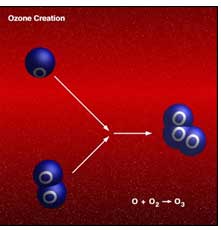
Ozone Properties
• Molecular Formula - O3
• Molecular Wight - 48.0
• Production - Corona Discharge.
• Concentration - up to 18% by weight in oxygen/oxygen enriched air
• Boiling Point - -111.9 Deg.C
• Melting Point - -192.7 Deg.C
• Solubility in water by weight @200C.
• Vapor Density - 1.6(air-1.0)
Appearance & Odor
Ozone is colorless at all concentrations experienced in industry. It has a pungent characteristic odor usually associated with electrical sparks. The odor is generally detectable by the human nose at concentrations of 0.02 and 0.05 ppm.
Fire/Explosion and Hazard data
Ozone is a powerful oxidizing agent. Oxidation with ozone evolves more heat and usually initiates at a lower temperature than oxidation with oxygen. Ozone reacts with non-saturated organic compounds to produce ozonides, which are unstable and may decompose with explosive violence. Ozone is an unstable gas that, at normal temperatures, decomposes to bi atomic oxygen. At elevated temperatures and in the presence of certain catalysts such as hydrogen, iron, copper and chromium, this decomposition may be explosive.
Health Hazard Data
Permissible Exposure Limits
• EPA Discharge Limits - 1.0 ppm to Atmosphere.
• OSHA Exposure Limit - 0.1 ppm for 8 hrs & 0.3 ppm for 10 minutes
Toxicology of Ozone
The acute and chronic effects of excessive exposure to ozone have been well investigated. Exposures to concentrations of ozone in excess of several tenths of a ppm sometime cause reports of discomfort in a small susceptible portion of the population. This can be in the form of headaches or dryness of the throat and mucous membranes of the eyes and nose following exposures of short duration. Repeated exposure to ozone at such concentrations at24-hour intervals, however, caused no further increase in airway irritability. In fact, after the first exposures, additional exposures to ozone had progressively lesser effects suggesting that Tolerance may develop over time.
Ozone has been shown to be more injurious at concentrations exceeding 2.0 ppm over several hours, such as experienced by gas shielded arc welders. The primary site of acute effects is the lung which is characterized by pulmonary congestion. This acute impact Subsided in welders when exposures were reduced to less than 0.2 ppm. Based on animal studies, exposures over 10 to 20 ppm or an hour or less are believed to be lethal in humans although there has never been a single recorded fatality attributed to ozone exposure in more than 100 years of commercial use. (Compare this experience with Chlorine gas which has claimed many victims in peacetime as well as during war). With respect to long term or chronic toxicity, ozone is a radiomimetic agent. i.e. the effects of long term exposure to excessive ozone exhibits the same effects as excessive exposure to sunlight. These effects are drying of the dermal surfaces and general ageing of exposed tissues. Ozone is not generally regarded or suspected of being a human carcinogen, neither does it exhibit tertogenic or mutagenic properties.
Precautionary Measures
• In the event of ozone leak a Ventilate the area.
• Immediately switch the ozone generator off.
• Where high levels of ozone are experienced (in excess of 0.1 ppm), all personnel should vacate the affected area until it has been thoroughly ventilated.
• Where ozone levels in excess of 0.3 ppm are present, or when personnel are required to work in restricted spaces or tanks, where ozone may be present, only persons wearing suitable breathing apparatus should be allowed in the area and the appropriate safe working practices for confined areas should be applied.
Disposal of waste ozone gas
It is accepted practice, and required by statute in some jurisdictions, that Ozone gas should not be released into the atmosphere but should be destroyed using an approved ozone destruction method.
Plant Engineering Considerations
• All potential outlets for ozone gas into the occupied areas or external atmosphere should be identified. All routine operational releases of ozone to the occupied areas or the external atmosphere should be contained and passed through an ozone destruction system.
• All occupied areas where ozone is generated or applied should be provide with an effective ventilation system commensurate with the rate of ozone production and other risk factors. Suitable masks or breathing apparatus should be readily available for the protection of personnel in the event of leakage and for protection where working requirements make it impossible to avoid contact with ozone.
First Aid Measures
• Eye Exposure - If ozone gets into the eyes, wash eyes immediately with large amounts of water, lifting the upper and lower eye lids occasionally. Seek medical attention as soon as possible.
• Breathing - If a person breathes in large amounts of ozone, move the person into warm-contaminated air at once. If breathing has stopped, perform artificial respiration. When breathing is difficult, properly trained personnel may assist by administering breathing oxygen. Keep the affected person warm and at rest. Seek medical attention as soon as possible.
• Rescue - Move the affected person to safety. If the person has been overcome notify somebody else and put into effect the established emergency procedures. Do not enter the affected area without assistance or against the advice of the recommended safety procedures as they may apply at each facility.

Head Office: 28, Satyam Industrial Estate, Subhash Road, Jogeshwari (East), Mumbai, Maharashtra 400060